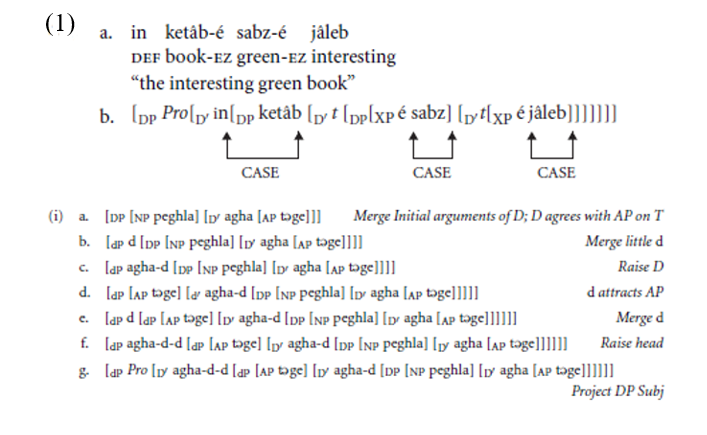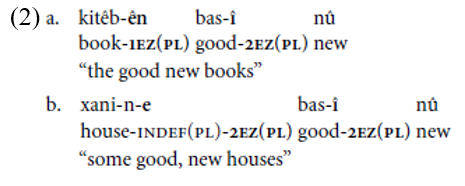


 Grammar
Grammar
 Tenses
Tenses
 Present
Present
 Past
Past
 Future
Future
 Parts Of Speech
Parts Of Speech
 Nouns
Nouns
 Verbs
Verbs
 Adverbs
Adverbs
 Adjectives
Adjectives
 Pronouns
Pronouns
 Pre Position
Pre Position
 Preposition by function
Preposition by function 
 Preposition by construction
Preposition by construction
 Conjunctions
Conjunctions
 Interjections
Interjections
 Grammar Rules
Grammar Rules
 Linguistics
Linguistics
 Semantics
Semantics
 Pragmatics
Pragmatics
 Reading Comprehension
Reading Comprehension|
Read More
Date: 2025-04-06
Date: 2024-01-05
Date: 2024-01-19
|
Ezafe construction again
Suppose now that a language had in its D-system the equivalent of a “generalized genitive preposition” – an item that could be inserted to check Case on [+N] determiner complements. A single, additional Case would then become available for each such Case-marker, allowing APs/NPs/nominal PPs to remain in situ. Relative clauses and non-nominal PPs would not require such an element, and so none would appear.
We propose that this is what’s happening in the Ezafe construction. Modifying NPs, APs, and (nominal) PPs are selected by D and generated post nominally as usual. As [+N] elements they bear Case features, and are Case-licensed by Ezafe in their base-position. We will tentatively consider Ezafe to form an XP phrase with its complement, but to cliticize onto the preceding [+N] element for phonological reasons. So the picture, for a simple Farsi NP like (1a), is as in (1b). The definite determiner in checks its one Case feature on its restriction. Ezafe is inserted and licenses the remaining modifiers in their base positions.

Again, relative clauses (CPs) and non-nominal PPs do not require Case. Hence they can appear in their base site (like English RCs and PPs) without the need for a licensing Ezafe.
Under this proposal, Ezafe languages are special insofar as they reveal the deep position of all nominal modifiers. They can do so because they have a special Case-marking device.
Interesting evidence for the tie between D and Ezafe comes from Kurmanji, which also has the Ezafe construction, but which differs from Farsi in important subtleties. In brief, Kurmanji exhibits an alternation in the form of Ezafe according to definiteness. Kurmanji definite DPs with iterated modifiers show so-called primary Ezafe between the noun and its first modifier, but a distinct secondary Ezafe thereafter (2a). By contrast, Kurmanji indefinite DPs with iterated modifiers show secondary Ezafe throughout (2b).

Definiteness is very widely held to be an interpretable/meaningful property of determiners insofar as it is the semantics of D that establishes whether a nominal is definite or indefinite (Barwise and Cooper 1981; Diesing 1992; Keenan and Stavi 1994). Thus Kurmanji, which exhibits a distinct Ezafe for definiteness, would seem to indicate a relationship between Ezafe and D. In the theory developed here, the relation between Ezafe and (null definite/ indefinite) Dis in fact selectional:Dselects EzP, hence this link is captured directly.
|
|
|
|
لخفض ضغط الدم.. دراسة تحدد "تمارين مهمة"
|
|
|
|
|
|
|
طال انتظارها.. ميزة جديدة من "واتساب" تعزز الخصوصية
|
|
|
|
|
|
|
طائرة شراعية تزيّن سماء كربلاء المقدّسة بلافتة حفل تخرّج طلبة الجامعات العراقية
|
|
|